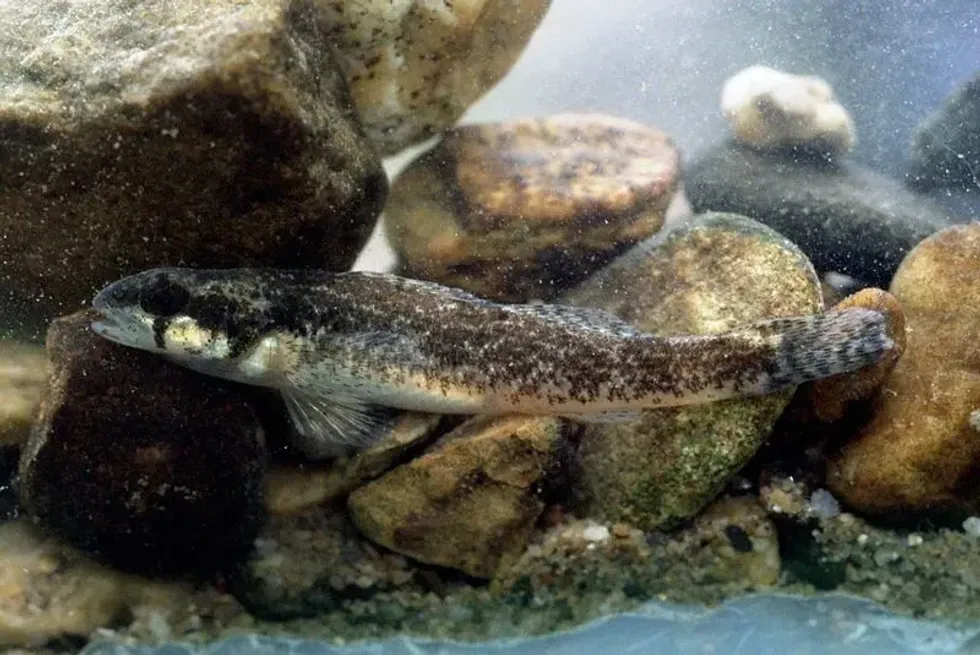Have you ever heard of a small colorful fish with three dorsal saddles? If you haven't heard, it is known as the trispot darter.
They come under the family Percidae, and their members include Crystallaria, Ammocrypta, and Percina. Some of the darter species are spread throughout North America, mainly in Alabama, Georgia, and Tennessee. Their habitat comprises small and medium river tributaries and seepage areas.
The trispot darter can be differentiated from the members of its subgenus, Ozarka, by a lateral line, single anal spine, and supratemporal canal. The back of this small fish species is yellow-brown with three dark brown saddles.
The breast and venter are yellow or white. The front side of the breeding males is bright orange. The dorsal fin has red spots.
Explore in-depth information about the trispot darter, which is listed as Threatened under the Endangered Species Act. Also, collect more information and enhance your knowledge further with rockfish facts and green sunfish facts.
Trispot Darter Interesting Facts
What type of animal is a trispot darter?
The trispot darters (Etheostoma trisella) are popular small, perch-like fish found in the rivers of the North American region. They are cold-water fish and avoid living in polluted water. Unfortunately, these often raise critical habitat issues for this species to live in the contaminated river basins. For this reason, many darters have been listed as endangered species or vulnerable.
One of the unique features of trispot darter is that it requires two different habitat connectivity areas to complete its life cycle. First, for non-breeding adults, it requires low-velocity habitat areas like edge waters and backwater pools. Then, for spawning, the adults move to the small streams in late autumn.
What class of animal does a trispot darter belong to?
The trispot darter belongs to the class Actinopterygii and the family Percidae.
How many trispot darters are there in the world?
The exact number of the trispot darter is not mentioned. However, under the Endangered Species Act, it is considered vulnerable and has become a threatened species.
The population of trispot darters is declining due to the loss of habitat and climate change. In addition, their water habitat areas have been contaminated due to urbanization, stormwater runoff, watershed disturbances. However, with protection acts, efforts to preserve critical habitat, and good water quality, the darters, can be saved.
Where does a trispot darter live?
The trispot darter (Etheostoma trisella) can be found in the small and medium river margins, tributaries, and seepage areas. Their habitat range comprises the Conasauga River and its tributaries located in southern Tennessee and northern Georgia, Cherokee County, the Alabama River, the Coosa River, the Coosawattee River, Little Canoe Creek basin, and Lake Weiss.
Critical habitat designation is given to the Conasauga River for the protection of the Etheostoma trisella species.
What is a trispot darter's habitat?
The habitat range of trispot darters depends on their breeding and non-breeding habits. During the non-breeding months from April to October, its habitat comprises small to medium river systems and low tributary areas with low velocity. It primarily resides in parts of the areas with logs, residues, and substrates.
Darters swim towards the main channel during the low flow periods. Its spawning habitat comprises seepage areas where they will remain from winter to spring. They are primarily found in the freshwater region or parts of the little canoe creek, Coosa River, and Coosawattee River.
A proposal to give critical habitat for the Etheostoma trisella is essential. The local bodies of Alabama state, Georgia state, and the state of Tennessee value the private conservation efforts.
Who do trispot darters live with?
Trispot darters live alone or in groups known as schools.
How long does a trispot darter live?
The lifespan of the trispot darter fish is around two and a half years.
How do they reproduce?
Spawning occurs from January to March. They require a stable winter water temperature to spawn near the groundwater. Also, the spawning habitat must comprise a heavily vegetative area like marsh grasses. The spawning males are brightly colored and court the females within this range.
Females lay around 50- 300 eggs. The eggs are found attached to the plants and rocks.
Later in the spring season, when the young ones are matured enough, they return to the large streams with the adults. The spawning individuals are generally one year old.
What is their conservation status?
The conservation status of trispot darter is Vulnerable. However, due to the decrease in population, it is protected under the Endangered Species Act.
Due to critical habitat issues for the darters, conservation measures and proposal has been announced by the U.S Fish and Wildlife Service, Center for Biological Diversity, and Atlantic Coast Conservancy. It is also conducting conservation easement donations for the protection of wildlife and plants.
Trispot Darter Fun Facts
What do trispot darters look like?
 *Please note that this is an image of a Kentucky arrow darter, not a trispot darter. If you have an image of a trispot darter, please let us know at hello@kidadl.com
*Please note that this is an image of a Kentucky arrow darter, not a trispot darter. If you have an image of a trispot darter, please let us know at hello@kidadl.comThe trispot darter is a small fish. Its back is brown-yellow, and the front side is white or yellow. It has three dark brown saddles and dark brown eyes. The dorsal fin has red spots.
The front side of the breeding males is bright orange. Their fins are dusky and have green patches on the sides of the body. The front of the breeding males is bright orange. It has four to five irregular green lateral lines.
How cute are they?
The darters are cute little colorful freshwater fish comprising brown-yellow color on the backside and white or yellow on the front side, and the dorsal fin has red spots.
How do they communicate?
Commonly, most small fishes are known to communicate by signals and motions. They are also known to communicate with the help of the release of chemicals.
Other ways of communication include sound, bioluminescence, smell, and color. These forms of communication are usually helpful during spawning to keep away from predators and while fighting. Just like humans, fish can communicate with one another.
How big is a trispot darter?
The trispot darter is 1.4 in (35 mm) in length.
The trispot darters are three times smaller than the amber darters.
How fast can a trispot darter swim?
The swimming speed of the trispot darter is not mentioned. However, a small river water fish species swim at a speed of 70 mph (112.7 kph).
How much does a trispot darter weigh?
The weight of the trispot darter fish species is not mentioned. However, it weighs less than the amber darter.
What are the male and female names of the species?
Females are known as female trispot darters, and males are known as male trispot darters.
What would you call a baby trispot darter?
A baby trispot darter is known as fry.
What do they eat?
The diet of the trispot darters includes mayfly nymphs, midge larvae, and pupae.
Are they aggressive?
No, trispot darters are not aggressive.
Would they make a good pet?
Yes, trispot darters would make a good pet just like a neon tetra or a black molly. You can keep them in your aquarium. It is sure to gain attention with its vibrant color. If you have them as pet fish in your aquarium, keep a watch on their food menu.
Did you know...
One of the special characteristics of the trispot darter species is that it has the habits of a tiny salmon. It migrates from a large freshwater river to a small freshwater tributary, where it spends most of its life and spawns.
Trispot darters have a unique appearance as compared to the other darter species in the Upper Coosa River Basin. Trispot darters have a brown-yellow body and three dark dorsal saddles.
In comparison, the amber darters are larger, around 3.1 in (80 mm), and have a pointed snout. In addition, during the spawning season, the male trispot darter's body becomes brightly colored, while the amber darter species show small tubercles.
Is the trispot darter endangered?
Yes, the Etheostoma trisella species is listed as Vulnerable due to its declining population.
The threats darters face are loss of habitat through the development of land, stream impoundment, climate change, and watershed disturbances.
Measures to protect them include: protecting the habitat quality in the mainstream river waterways region and their tributary system, getting rid of sedimentation from land construction, maintaining forested buffers near the river banks, stop contamination of river water, stormwater runoff, improve the watershed, and maintaining the natural flow of the rivers.
Natural Resource Conservation Service work and management practices by the biologists and implementing strategies by the farmers can preserve the land for future generations.
Many natural resource conservation act has been implemented by the U.S fish wildlife service/ U.S fish and wildlife service, also the Center for biological diversity, Atlantic coast conservancy.
The only way to save the darters is to improve the nation's navigation system. By improving the navigation system will play a positive response on the environment. Protection of the Etheostoma trisella is essential for future generations to survive.
How did Trispot Darters get their name?
Etheostoma means strain mouth, which most probably refers to smallmouth. The other word Trisella means three-saddle in comparison to the three dorsal saddles present.
Here at Kidadl, we have carefully created lots of interesting family-friendly animal facts for everyone to discover! Learn more about some other fish including monkfish facts and rainbow trout facts.
You can even occupy yourself at home by coloring in one of our free printable Trispot darter coloring pages.




 *Please note that this is an image of a Kentucky arrow darter, not a trispot darter. If you have an image of a trispot darter, please let us know at hello@kidadl.com
*Please note that this is an image of a Kentucky arrow darter, not a trispot darter. If you have an image of a trispot darter, please let us know at hello@kidadl.com



